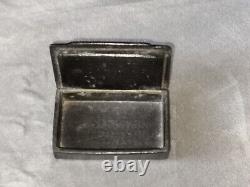
- Home
- Authenticity
- Material
- Origin
- Style
- 1940-1960 (159)
- Antique (72)
- Antiquity (164)
- Antiquité (301)
- Art Populaire (19)
- Directoire (32)
- Louis Philippe (69)
- Louis Xiii (39)
- Louis Xiv, Baroque (124)
- Louis Xvi (90)
- Moyen-âge (61)
- Napoleon Iii (207)
- Napoleon, Empire (29)
- Napoléon Iii (423)
- Napoléon, Empire (75)
- Ottoman (51)
- Renaissance (104)
- Restauration (32)
- 1900 (27)
- 1970 (31)
- Other (2938)
- Sub-type
- Type
English translation: 17th-18th Century Masonic English Checkerboard Lid Blackened Wooden Snuffbox





Very old pocket snuff box, made of noble blackened wood (checkered lid, certainly Masonic). A pocket snuffbox must be flat and small in size to easily fit in the pocket. Its shape should help the hand to hold it horizontally; its opening should be sufficient to allow a pinch with two fingers and its closure perfectly tight to avoid any unwanted moisture. Snuff tobacco, somewhat exotic, was mainly reserved for the delicate nostrils of aristocrats, then bourgeois, while the plug could only be suitable for the most rustic mouths. Snuffing was initially done for medicinal purposes and then for pleasure. Man snuffing with his snuffbox in hand. Snuffing tobacco became very popular in Europe, and in European salons, it was common to be interrupted in conversation by the sound of a sneeze, then considered distinguished. Women snuffed with as much fervor as men. It was fashionable to change snuffboxes every day. They readily adapted to the clothing and moods of their owner. Extracted from the pocket or a small bag, they were passed from hand to hand in salons, which allowed to determine the social rank and wealth of the owner. Therefore, the often decorated snuffboxes became the latest fashion accessory but also an important symbol of social status. As such, the snuffbox was often offered as a gift or worn as jewelry.
They were gladly offered as tokens of love with the portrait of the loved one, or to signify friendship. Precious models, filled with silver or precious stones, became diplomatic or military gifts.
King Louis XIV, who was not a snuff-taker, had many of them made, very expensive, to offer to representatives of foreign powers with whom he had dealings. Snuffboxes were then mainly made of gold enhanced with precious stones, silver, enamel, mother-of-pearl, porcelain, oriental lacquer, or Martin varnish (imitation lacquer). With time and the growth of its culture (the powdered tobacco from the farmers was mainly produced in Morlaix and highly appreciated), tobacco became increasingly popular and eventually reached all layers of society. Thus, at the Revolution, the snuffbox was no longer reserved for the wealthy, tobacco became democratized and the people snuff.
The snuffbox also became the rallying sign of the sans-culottes and was widely used by the army. Gold was replaced by "pomponne", developed by two goldsmiths, Turgot and Daumy, established in the late 18th century in the Hotel de Pomponne, rue de la Verrerie in Paris. It is an alloy based on copper intended to imitate gold or silver. Louis XV granted them a manufacturing privilege, whereas until then, all imitation was prohibited. New materials emerged: papier-mâché, leather, bark...The servant, the washerwoman, like the poorest of peasants also had their "snuff box". Thus, initially sold only by apothecaries, tobacco ended up on display behind grocery counters before joining certain gaming houses and beverage outlets called "tobacconists". There are many shapes and sizes of snuffboxes, either pocket or table, depending on their use outdoors or indoors.

